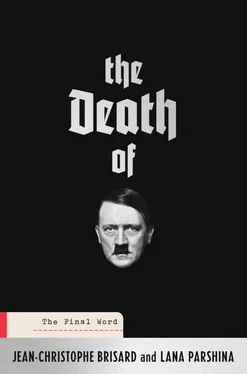Question to Günsche:What can you say about Höfbeck’s witness statement?
Günsche’s reply:It wasn’t at about 2:00 pm, but shortly after 4:00 pm that the bodies left the bunker by the emergency exit. […] I didn’t help to carry Adolf Hitler’s body, but a little while later I passed through the emergency exit with Frau Hitler’s body. Adolf Hitler’s body was carried by people I’ve already mentioned in previous interrogations. […]
Question to Höfbeck:Do you have any objections about Günsche’s testimony that you have just heard?
Höfbeck’s reply:I have no objection to Günsche’s testimony that I have just heard. […] I have to say that my previous statement may contain some inaccuracies, given that these unexpected events have unsettled me very much.
The inaccuracies in the witness statements drive the investigators mad. Are the prisoners doing it on purpose? There are strong reasons for thinking they are. Let us not forget that for the Nazis, the Communists embody absolute evil (according to Hitler’s doctrine, just after the Jews). Resisting, lying, or distorting reality may seem natural to men inspired by Nazi fanaticism that is still very much alive. Be that as it may, their contradictory answers complicate the precise establishment of the events that preceded the fall of Hitler’s bunker.
Lana and I thought we were sufficiently prepared for this plunge into one of the last mysteries of the Second World War. Big mistake. Even in our most pessimistic scenarios, we couldn’t have imagined the level of complexity of an investigation such as this. We would soon discover that the collection of documents in the GARF stores wouldn’t be the hardest part. Our confidence and optimism were quickly dampened. It was Dina, the head of GARF’s special collection, who alerted us.
Let’s return to our meeting during autumn break 2016 within the walls of the Russian State Archives. Lana and I were busy thanking Dina and Nikolai for their patience. They had already filled the shopping trolley with the pieces of wood from the sofa and the files about Hitler. The interview ended cordially. “We succeeded, we have all the documents about the disappearance of the Führer, it’s a first!” Lana was getting carried away and I let her. Dina didn’t share her enthusiasm. Nikolai had already left without saying a word. We could hear him pulling his trolley along the corridors with the same delightful racket as before. “You haven’t got everything,” Dina suddenly announced, almost sorry to spoil our pleasure. Not everything? “There are still bits of Hitler elsewhere in Russia?” I asked without really believing it myself. “It’s possible…” Dina had trouble answering frankly. “In fact, yes,” she acknowledged at last. “But you won’t be able to see them.” Our house of cards was collapsing. Still biting her lips and avoiding our eyes, Dina felt uneasy. Lana started talking to her as gently as possible to reassure her. To tell her that it wasn’t very serious, but she had to explain everything.
Good news and bad news. Where did I want to start? Lana let me choose. We had left the GARF offices and caught a taxi to get back to our hotel. Let’s start with the bad news. “Not all the Soviet reports on Hitler’s death are kept at GARF. Some of them are stored in the archives of the FSB.” Silence… Was there more bad news? Not for certain. The three initials mean “Federalnaya Sluzhba Bezopasnosti” (Federal Security Service), the Russian secret service. The FSB was set up in 1995. In a way, this was the successor to the KGB, which had been dissolved on 11 October 1991, following an attempted coup d’état against Mikhail Gorbachev in August 1991. The FSB’s methods haven’t fundamentally changed from those of its illustrious elder sibling. Methods based on manipulation and, if necessary, violence. If access to GARF had seemed difficult, how hard would it be to get into the archives of the FSB (the TsA FSB, short for Tsentral’ny Arkhiv FSB)? Lana was almost laughing, our quest had taken such a desperate turn. “There’s something else you need to know,” she continued with a nervous hiccough. “Dina also told me that we would certainly have to dig in the military archives. On the other hand, she was very clear, we can’t expect any help from GARF. The FSB, the military archives, and GARF all hate each other. We’re going to have to manage on our own.”
The taximeter was ticking off the roubles that our route was going to cost. It all seemed so easy for the driver. Two customers, an address, a good GPS, and he was all set. The exact opposite of our investigation. “You don’t want to know the good news? The positive thing that Dina wanted to tell us?” Lana sensed that I was growing weary. Over a year of Sisyphean research was beginning to dent my enthusiasm. “Dina assured me that she liked us, and that she’d support us in our bid to carry out scientific examinations on the skull.” Did Dina have the slightest power over the examination of the skull? Lana started thinking, and then shook her head. Moscow was playing with us, with its fine drizzle. Other people had tried to investigate Hitler. If they’d all failed, was it a coincidence?
A fierce and almost desperate combat? Perfect! Lana doesn’t give up, quite the contrary. She promised me she would obtain all the permissions before the end of the year, the ones that we needed to access the FSB archives and those opening the doors of the Russian State Military Archives (RGVA). “No one resists me for long. I will wear them down,” she assured me with her swaggering air in the departure hall of Sheremetyevo Airport in Moscow. That was less than a month ago. Since then, not a day goes by when I don’t talk to her on the telephone, when we don’t give each other encouragement. I’ve been working on the documents, she’s been working on the Russian authorities. “I’m nearly there, another few days and I’ll have my answer. Stay alert, we’re going to need to react quickly.” Lana doesn’t let go, and she can’t imagine a second failure. Are her connections with Russian power really so solid? How would she convince administrations that were usually so impervious to this kind of request? “Since my work on Svetlana Stalin, I can count on good relations with people of influence, and they know me, they know I’m like a pit bull. I never let go of my prey. And believe me, dictators know me…”
PART II
THE LAST DAYS OF HITLER
As of March 1945, Hitler decided to take refuge in his bunker beneath the new Reich Chancellery, in the heart of Berlin. The big final Allied offensive was launched a few weeks earlier. In the East, the Red Army, after a first failed attempt in October 1944 (Operation Gumbinnen), entered Eastern Prussia on 20 January; the Western Allies (in this instance the troops of the 1st American Army) had also entered German territory on 12 September 1944, near Aachen. The city would fall on 21 October. As the threat became more clearly apparent, Hitler left his refuge less and less often. He spent the last days of his life 8.5 metres underground. All of the details of the Führer’s last moments are supplied by the survivors of the bunker. Those men and women were mostly military personnel, as well as a few civilians (particularly secretaries). Their witness statements need to be treated with caution. Let us not forget that they were all members of the Nazi Party and, to varying degrees, admired Hitler.
These statements come from two different sources: the interrogations carried out by the Soviets and/or the Allies after the arrest of the witnesses, and the witnesses’ memoirs which they published after being freed, as well as a number of interviews. In the first instance, the information was taken by fair means or foul, not intended to be published and revealed to the wider public; in the other, it came freely from the individuals themselves. It allowed them to justify their own actions to the whole world and, most often, distance themselves from the Nazi regime.
Читать дальше












